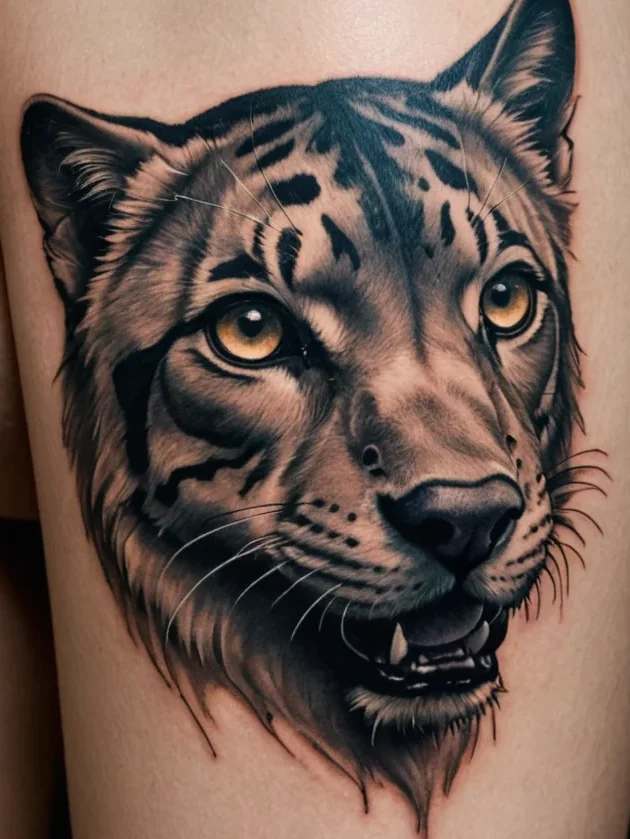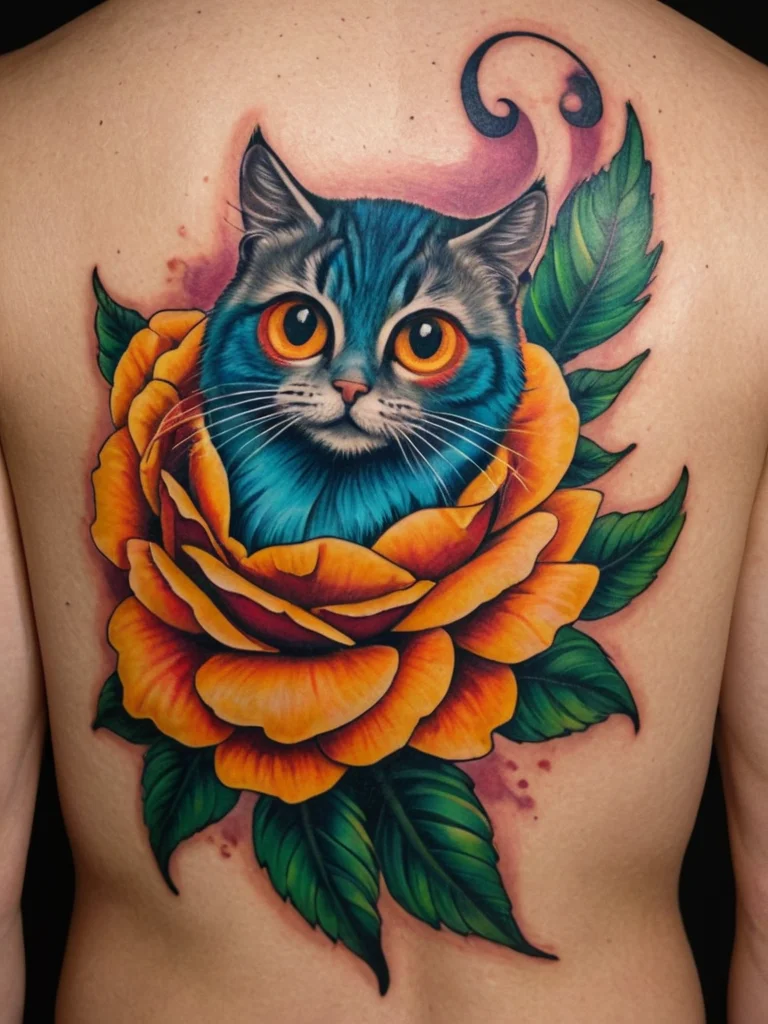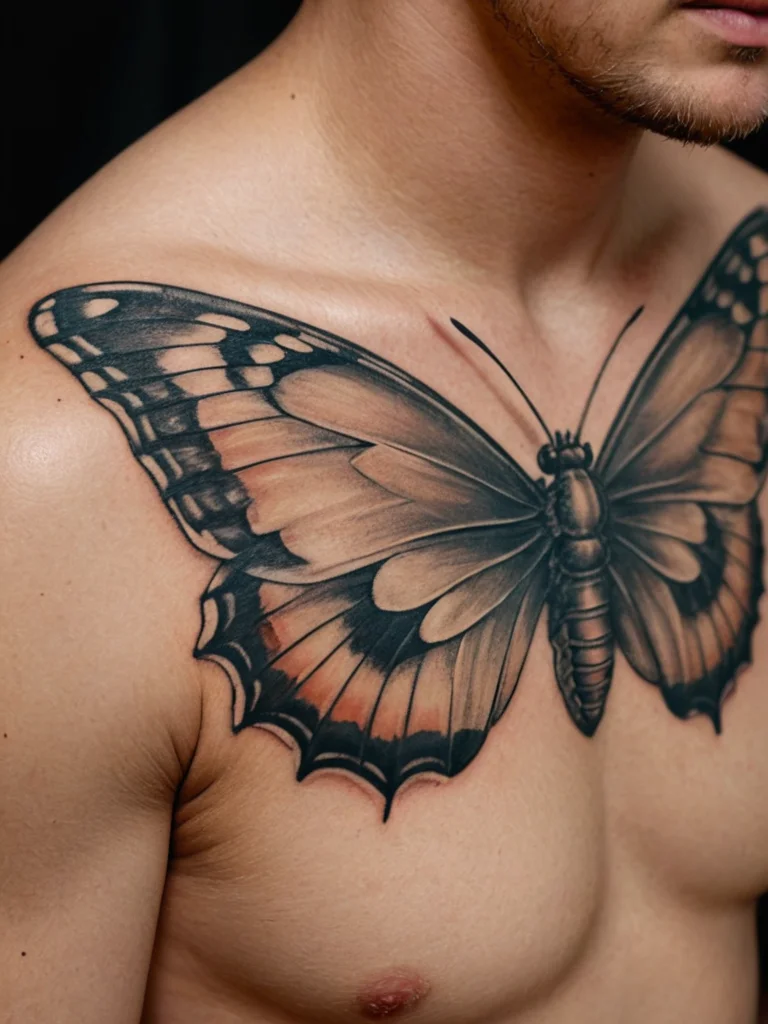Introduction: Why tattoo longevity matters and what to expect after 20 years
The allure of a tattoo lies not only in its initial beauty but also in its enduring quality. A well-executed tattoo can remain a cherished piece of art for decades, a testament to a moment in time, a personal belief, or a creative expression. However, like any form of art exposed to the elements and the passage of time, tattoos inevitably change. Understanding how tattoos age over 20 years and beyond is crucial for anyone considering getting inked. It allows you to make informed decisions about design, placement, and aftercare, ensuring that your body art remains a source of pride rather than regret. After two decades, you can anticipate some fading, softening of lines, and potentially some blurring depending on various factors discussed below.

Factors influencing tattoo aging: skin type, ink color, placement, and aftercare
Several key factors determine how well a tattoo holds up over the long term. These include your skin type, the colors of ink used, the tattoo’s placement on your body, and, crucially, the aftercare you provide. Understanding these elements empowers you to optimize your tattoo’s longevity. Let’s explore each in detail:
- Skin Type: Your skin’s natural characteristics play a significant role. Individuals with oily skin might notice that their tattoos fade slightly faster due to increased sebum production pushing ink particles out of the dermis. Conversely, very dry skin, if not properly moisturized, can cause the tattoo to look faded or cracked over time. Fairer skin tends to show age-related changes like sun damage more prominently, affecting the tattoo’s vibrancy. Those with darker skin tones may experience less noticeable fading as the melanin provides some protection against UV rays, although scarring and keloid formation can be more pronounced.
- Ink Color: Not all tattoo inks are created equal, and their chemical compositions affect their longevity. Black ink, traditionally carbon-based, tends to be the most stable and longest-lasting. Dark blues and greens also generally hold up well. Lighter colors, such as pastels, yellows, and oranges, are more prone to fading because they contain pigments that are more susceptible to breaking down from sun exposure and the body’s natural processes. Red ink, while vibrant, can sometimes be problematic. Some red pigments are known to cause allergic reactions or fade more quickly than other colors. White ink, often used for highlights, tends to yellow or disappear over time, especially if overexposed to the sun. Tattoo artists recommend considering this when choosing a color palette; integrating black outlines can help preserve the design’s overall structure even if some colors fade.
- Placement: Where you get your tattoo significantly impacts how it ages. Areas that experience a lot of friction or stretching, such as the hands, feet, elbows, and knees, tend to fade more quickly. The skin in these areas regenerates more rapidly, causing the ink to disperse over time. Tattoos on areas exposed to frequent sun exposure, like the shoulders, back, and chest, will also fade faster if not protected with sunscreen. Areas with more subcutaneous fat, such as the stomach, thighs, and upper arms, are generally good choices for tattoo longevity, as the skin is less prone to stretching and wrinkling. The inner bicep is often cited as an excellent location due to minimal sun exposure and less friction. Rib tattoos, while popular, can be susceptible to distortion due to weight fluctuations and skin elasticity changes.
- Aftercare: The initial weeks following your tattoo session are critical in determining its long-term appearance. Proper aftercare involves keeping the tattoo clean, moisturized, and protected from the sun. Tattoo artists universally recommend following their specific aftercare instructions meticulously. Neglecting aftercare, such as exposing the tattoo to direct sunlight before it’s fully healed, picking at scabs, or failing to moisturize regularly, can lead to scarring, ink loss, and a significantly faded tattoo. Proper aftercare includes gentle washing with mild soap, applying a thin layer of recommended ointment or lotion, and avoiding excessive soaking in water (such as swimming or long baths) during the healing process. Sunscreen is an essential part of long-term aftercare, even years after the tattoo has healed.

Visual guide: examples of tattoos aged 20+ years (good and bad examples)
Seeing is believing. Examining real-life examples of tattoos that have aged over two decades provides valuable insight into the aging process and the impact of different factors. Below are descriptions of tattoos with explanations, focusing on both examples of well-maintained tattoos and those that have suffered from poor care or placement.
- Example 1: The Well-Preserved Back Piece: Imagine a large back piece featuring intricate Japanese-style artwork. This tattoo, now over 20 years old, still boasts vibrant colors and crisp lines. The key to its longevity lies in several factors. First, the individual has fair skin but diligently applied sunscreen to the area whenever exposed. Second, the tattoo artist used high-quality, reputable inks, primarily black and dark blues, known for their durability. Third, the placement on the back avoids excessive stretching and friction. Fourth, and most importantly, the owner religiously moisturized the tattoo and protected it from sun damage throughout the years. The result is a tattoo that, while showing subtle signs of age, still retains its original beauty and artistry. You might see some slight softening of the lines, which is natural, but the overall design remains sharp and defined.
- Example 2: The Faded Ankle Tattoo: Picture a small, delicate floral tattoo on the ankle. Twenty years later, it’s a pale shadow of its former self. The colors, originally pastel pinks and yellows, have almost completely disappeared. The fine lines have blurred, making the design difficult to discern. Several factors contributed to this unfortunate outcome. The ankle is a high-friction area, constantly rubbing against socks and shoes. The light-colored inks used were inherently prone to fading. Sun exposure, especially during sandal season, further accelerated the process. In addition, the individual neglected to consistently apply sunscreen or moisturize the area. This example highlights the importance of placement and color choice in tattoo longevity. The original tattoo might have been beautiful, but the chosen location and ink colors were not conducive to long-term vibrancy.
- Example 3: The Black and Grey Sleeve: Visualize a full sleeve tattoo composed of black and grey realism. This tattoo, over two decades old, tells a different story. The solid black areas remain deep and rich, providing a strong foundation for the design. The grey shading, while slightly softer than when it was first applied, still retains its depth and dimension. The tattoo’s location on the upper arm, an area with less friction and sun exposure, has helped preserve its integrity. The owner has consistently moisturized the area and avoided excessive sun exposure. This example demonstrates the resilience of black and grey tattoos and the importance of proper placement and aftercare. While some minor fading is inevitable, the overall design remains clear and impactful.
- Example 4: The Distorted Stomach Tattoo: Envision a tattoo on the stomach that has significantly changed shape over 20 years. This is often the result of weight fluctuations or pregnancy. The design, once a crisp and well-defined image, is now stretched and distorted, with blurred lines and uneven ink distribution. The placement on the stomach makes it particularly vulnerable to these changes. While weight gain and loss can affect tattoos in other areas, the stomach is often the most noticeable. This example underscores the importance of considering potential future body changes when choosing a tattoo location. While not always avoidable, understanding the risks can help you make a more informed decision.
- Example 5: The Rejuvenated Tribal Band: Imagine a tribal band tattoo around the upper arm. Originally, the black ink was bold and solid, but over 20 years, some fading and patchiness occurred. However, the owner opted to have the tattoo touched up and revitalized by a skilled artist. The artist re-outlined the design with fresh black ink, filling in any faded areas and restoring its original intensity. This example illustrates the option of tattoo revitalization. While not all tattoos can be fully restored to their original condition, a skilled artist can often significantly improve their appearance. This requires careful assessment of the existing tattoo and the owner’s skin condition.
These examples provide a realistic understanding of how tattoos can age differently depending on various factors. They emphasize the importance of choosing an experienced artist, using high-quality inks, selecting an appropriate placement, and, most importantly, committing to lifelong aftercare.

Long-term aftercare: how to maintain tattoo vibrancy decades after getting inked
The initial aftercare regimen is crucial for healing, but long-term maintenance is what truly determines the longevity of your tattoo’s vibrancy. Think of it as preventative medicine for your body art. Consistent care, even decades after getting inked, will protect your investment and ensure that your tattoo continues to look its best. Here’s a breakdown of essential long-term aftercare practices:
- Sun Protection is Paramount: The sun is the single biggest enemy of tattoo ink. UV rays break down the pigments, causing fading and blurring. Make sunscreen your best friend. Tattoo artists cannot stress this enough. Apply a broad-spectrum sunscreen with an SPF of 30 or higher to your tattooed areas every day, even on cloudy days. Look for sunscreens specifically formulated for sensitive skin, as these are less likely to cause irritation. Consider using sun-protective clothing, such as long sleeves or rash guards, when engaging in outdoor activities. Remember, prevention is far easier and more effective than trying to repair sun-damaged tattoos later.
- Moisturize Regularly: Keeping your skin hydrated is essential for maintaining tattoo vibrancy. Moisturizing prevents the skin from becoming dry and cracked, which can make the tattoo look dull and faded. Apply a high-quality, fragrance-free moisturizer to your tattooed areas at least once a day, preferably after showering. Look for moisturizers that contain ingredients like shea butter, cocoa butter, or vitamin E, which are known for their hydrating and nourishing properties. Avoid using lotions with harsh chemicals or fragrances, as these can irritate the skin and potentially damage the tattoo.
- Avoid Harsh Chemicals: Exposure to harsh chemicals can accelerate tattoo fading. Be mindful of the products you use on your skin, such as soaps, detergents, and cleaning agents. Opt for gentle, natural alternatives whenever possible. When swimming in chlorinated pools or the ocean, rinse your tattooed areas thoroughly with fresh water afterwards. Chlorine and salt water can both be drying and damaging to the ink.
- Maintain a Healthy Lifestyle: Your overall health impacts the health of your skin and, consequently, the appearance of your tattoos. A balanced diet, regular exercise, and adequate sleep can all contribute to healthier skin and a more vibrant tattoo. Avoid smoking and excessive alcohol consumption, as these habits can negatively affect skin health and accelerate aging. Staying hydrated by drinking plenty of water is also essential for maintaining skin elasticity and preventing dryness.
- Exfoliate Gently: Gentle exfoliation can help remove dead skin cells and reveal brighter, more vibrant ink. However, avoid harsh scrubbing or abrasive exfoliants, as these can damage the tattoo. Use a soft washcloth or a gentle exfoliating scrub once or twice a week to buff away dead skin cells. Be sure to moisturize afterwards to replenish any lost moisture.
- Be Mindful of Skin Changes: As you age, your skin will naturally change. It may become thinner, less elastic, and more prone to wrinkles. Be aware of these changes and adjust your aftercare routine accordingly. You may need to moisturize more frequently or use richer, more emollient creams. Consult with a dermatologist if you have any concerns about your skin’s health or the appearance of your tattoos.
Long-term aftercare is an ongoing commitment, but it’s a worthwhile investment in the longevity of your body art. By following these simple guidelines, you can help ensure that your tattoos remain a source of pride and enjoyment for many years to come. Remember, consistency is key. Make sun protection, moisturizing, and gentle skincare a part of your daily routine.

Can old tattoos be refreshed? options for revitalization and cover-ups
Even with the best aftercare, tattoos inevitably fade and change over time. Fortunately, there are options for revitalizing old tattoos, breathing new life into faded artwork, or even completely transforming them with a cover-up. Understanding these options allows you to address concerns about aging tattoos and make informed decisions about their future.
- Tattoo Touch-Ups: A touch-up involves having a tattoo artist re-outline and re-color the existing tattoo. This is a common and effective way to revitalize faded tattoos and restore their original vibrancy. The artist will typically use the same colors and design as the original tattoo, but they may also make minor adjustments or improvements. Touch-ups are best suited for tattoos that have faded evenly and retain their basic shape. It’s crucial to choose an experienced artist who specializes in touch-up work. They should be able to accurately match the original colors and line work, ensuring a seamless and natural-looking result.
- Re-inking: Re-inking is similar to a touch-up, but it involves applying a completely fresh layer of ink to the entire tattoo. This is often necessary for tattoos that have experienced significant fading or ink loss. The artist will essentially re-trace the entire design, ensuring that all areas are saturated with fresh ink. Re-inking can dramatically improve the appearance of faded tattoos, restoring their original vibrancy and clarity. However, it’s important to note that re-inking can be more intense than a touch-up and may require a longer healing period.
- Color Bombing: This technique involves adding new, vibrant colors to an existing black and grey tattoo. This can be a creative way to revitalize an old tattoo and give it a fresh, modern look. The artist will carefully select colors that complement the existing design and apply them strategically to create depth and dimension. Color bombing can be particularly effective for tattoos that have become dull or lifeless over time. It’s essential to choose an artist with a strong understanding of color theory and experience in color bombing techniques.
- Cover-Up Tattoos: A cover-up tattoo involves concealing an old tattoo with a new design. This is a more drastic option, but it can be the best choice for tattoos that are heavily faded, poorly executed, or simply no longer desired. Cover-up tattoos require careful planning and execution. The artist must consider the size, shape, and color of the existing tattoo when designing the new one. Darker colors are typically required to effectively conceal the old ink. Cover-up tattoos are often larger and more complex than the original tattoos. Choosing an artist who specializes in cover-up work is essential. They should have the experience and skills necessary to create a beautiful and effective cover-up that completely conceals the old tattoo. Laser tattoo removal can sometimes be used to lighten the existing tattoo before applying a cover-up, making the cover-up process easier and allowing for a wider range of design options.
- Laser Tattoo Removal: While not exactly a method of refreshing a tattoo, laser tattoo removal is an option to either completely remove an unwanted tattoo or fade it significantly before a cover-up. The process involves using a laser to break down the ink particles in the skin, which are then gradually eliminated by the body. Laser tattoo removal typically requires multiple sessions and can be costly. It’s important to consult with a qualified dermatologist or laser technician to determine if laser tattoo removal is the right option for you.
Revitalizing an old tattoo or opting for a cover-up is a personal decision. Consider the condition of your tattoo, your desired outcome, and your budget when making your choice. Consult with experienced tattoo artists to explore your options and find the best solution for your individual needs. With the right approach, you can transform an aging tattoo into a piece of art that you continue to love for years to come.
